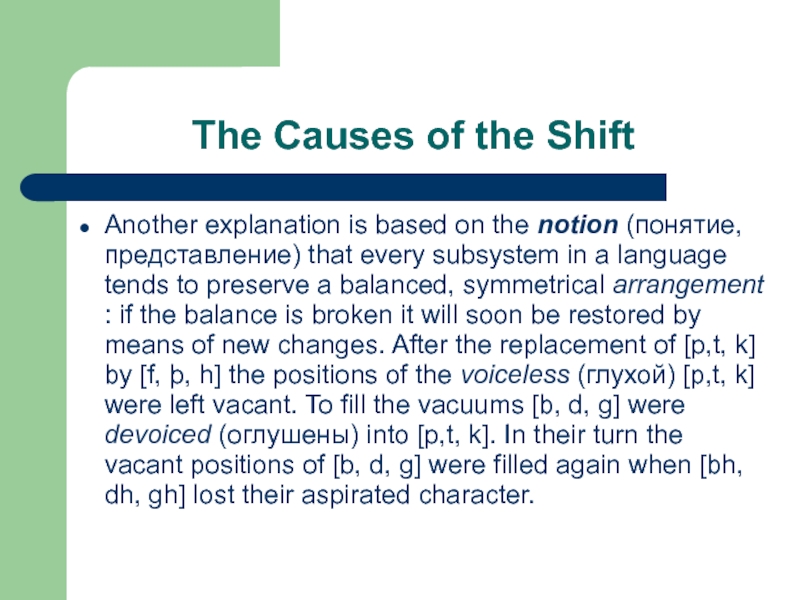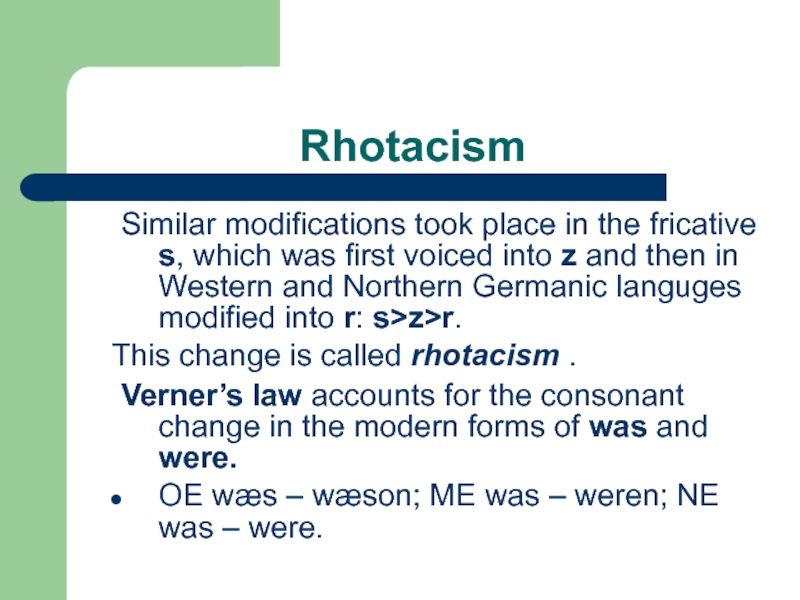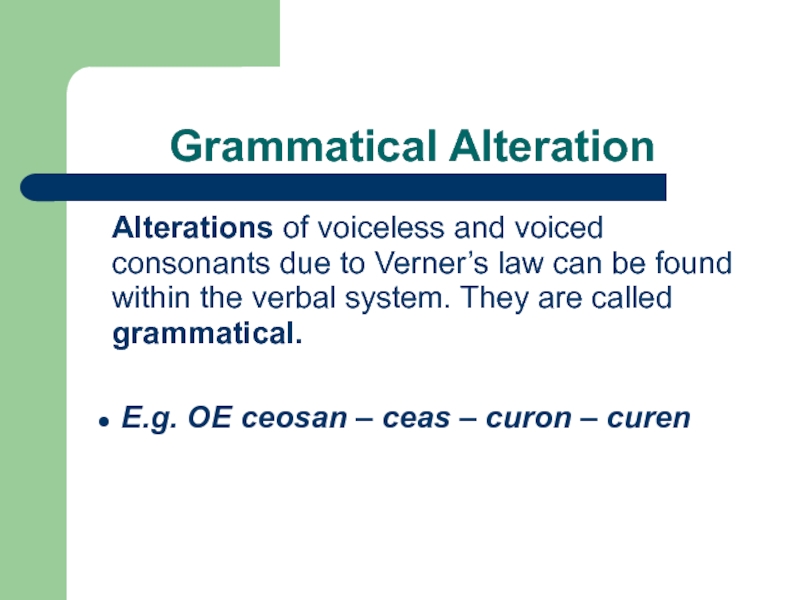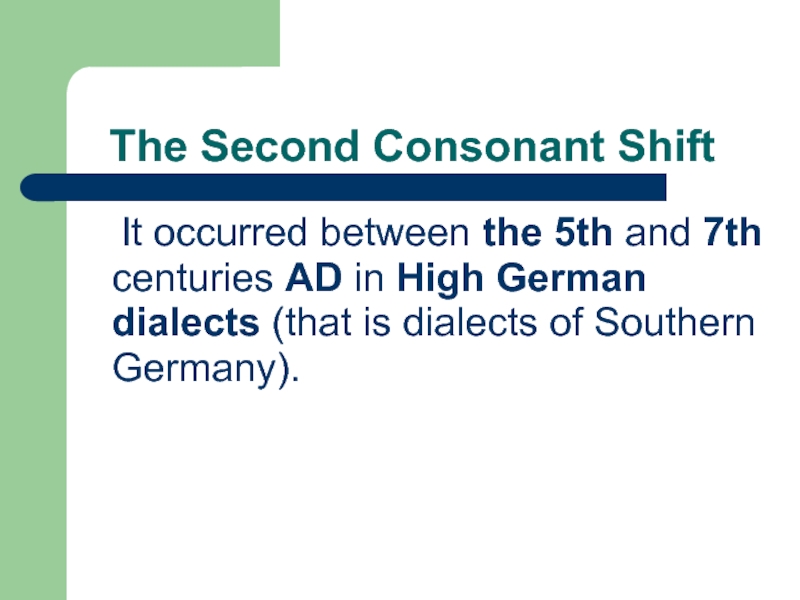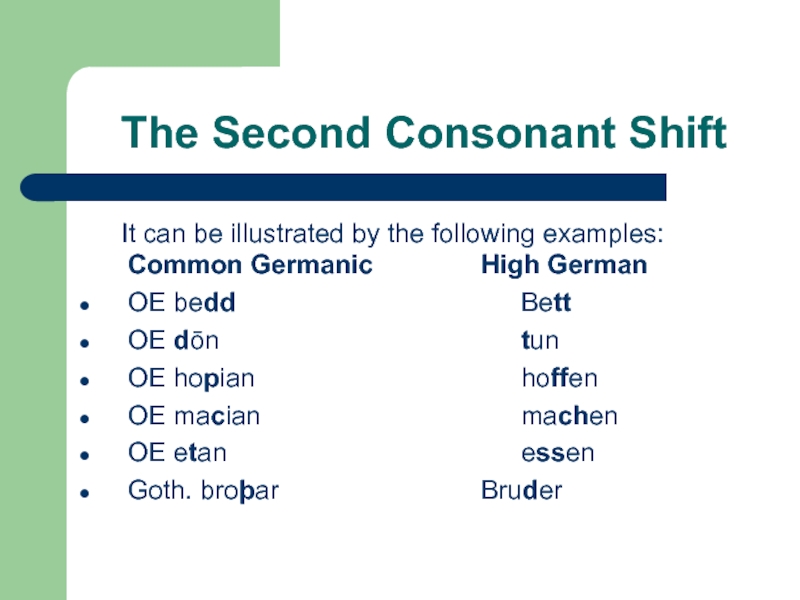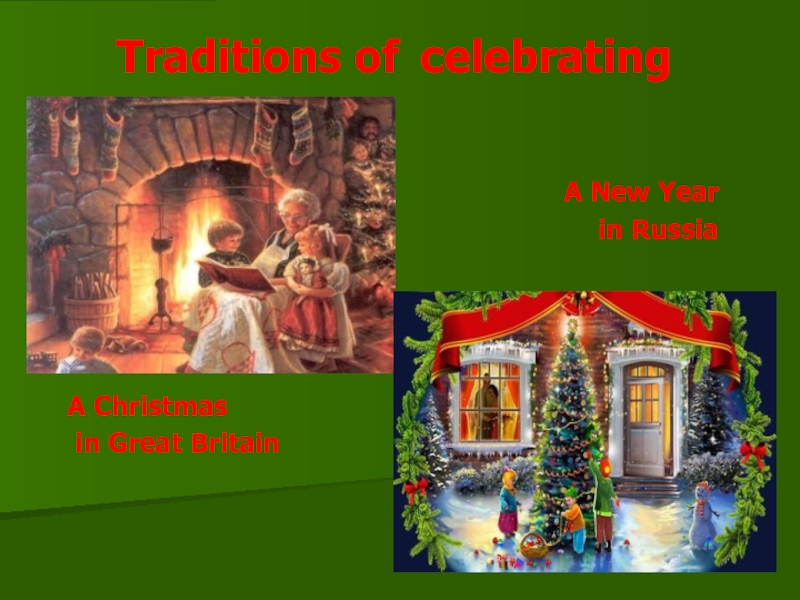- Главная
- Разное
- Дизайн
- Бизнес и предпринимательство
- Аналитика
- Образование
- Развлечения
- Красота и здоровье
- Финансы
- Государство
- Путешествия
- Спорт
- Недвижимость
- Армия
- Графика
- Культурология
- Еда и кулинария
- Лингвистика
- Английский язык
- Астрономия
- Алгебра
- Биология
- География
- Детские презентации
- Информатика
- История
- Литература
- Маркетинг
- Математика
- Медицина
- Менеджмент
- Музыка
- МХК
- Немецкий язык
- ОБЖ
- Обществознание
- Окружающий мир
- Педагогика
- Русский язык
- Технология
- Физика
- Философия
- Химия
- Шаблоны, картинки для презентаций
- Экология
- Экономика
- Юриспруденция
History of English. Lecture 1 презентация
Содержание
- 1. History of English. Lecture 1
- 2. 1. The Subject and Aim of the
- 3. VOCABULARY
- 4. VOCABULARY We can notice a considerable likeness
- 5. VOCABULARY In many cases English has a
- 6. The Phonetic Structure of the Language
- 7. The Grammatical Structure History of English will
- 8. The Purpose of this Subject So the
- 9. Classification of Germanic Languages The English language
- 10. Testimonies by Greek and Roman Writers
- 11. Testimonies by Greek and Roman Writers
- 12. Testimonies by Greek
- 13. 1. The Vindili Among them were
- 14. 1. The Vindili The Burgundians came
- 15. 2. The Ingvaeones (or Ingaevones).
- 16. 3. The Iscavones (or Istaevones).
- 17. 4. The Hermiones (or Herminones).
- 18. 5. The Peucini (певкины) (or Bastarnae).
- 19. 6. Hilleviones They inhabited Scandinavia.
- 20. Three Groups of Dialects 1. East Germanic
- 21. The First Consonant Shift The Common Germanic
- 22. The First Consonant Shift This
- 23. Three Groups of Correspondences I-E Germanic 1. p R.
- 24. The Causes of the Shift Some scholars
- 25. The Causes of the Shift Another explanation
- 26. Verner’s Law The correspondences marked by Grimm
- 27. Verner’s Law It is read as follows
- 28. Rhotacism Similar modifications took place in the
- 29. Grammatical Alteration Alterations of voiceless and
- 30. The Second Consonant Shift It occurred
- 31. The Second Consonant Shift It can be
Слайд 21. The Subject and Aim of the Course.
In studying the contemporary
English language the learners are faced with a lot of peculiarities which seem to be unintelligible.
These are found both in the vocabulary and in the phonetic and grammatical structure of the language. Let’s turn to some of them.
These are found both in the vocabulary and in the phonetic and grammatical structure of the language. Let’s turn to some of them.
Слайд 4 VOCABULARY
We can notice a considerable likeness between English and German.
E.
sit – G. sitzen,
E. winter – G.Winter,
E. long – G. lang,
E. apple – G. Apfel.
E. winter – G.Winter,
E. long – G. lang,
E. apple – G. Apfel.
Слайд 5 VOCABULARY
In many cases English has a lot in common with French:
E. river – Fr. riviére,
E. change – Fr. changer,
E. courage – Fr. courage
The causes of such similarities belong to a more or less distant past and they can only be discovered by going into the history of the English language.
Слайд 6 The Phonetic Structure of the Language
Any student of English faces
difficulties of reading and spelling English.
Why, for instance, the sound [ʌ] is spelt u in cut, butter but o in brother, love? Only the history of the language can answer this and many other questions.
Why, for instance, the sound [ʌ] is spelt u in cut, butter but o in brother, love? Only the history of the language can answer this and many other questions.
Слайд 7 The Grammatical Structure
History of English will explain why there are so
few inflections in English, how its “analytical” structure arose, why some nouns change the root-vowel in the plural and so on.
Слайд 8 The Purpose of this Subject
So the purpose of this subject is
a systematic study of the language’s development from the earliest times to the present day which will help the student to acquire a deeper understanding of the language of today.
Слайд 9 Classification of Germanic Languages
The English language belongs to the Germanic languages
which in their turn enter the vast Indo-European family. Nowadays Germanic languages are spoken in many countries.
We know that at the beginning of AD (наше время от лат. anno domini) Germanic tribes occupied vast territories in western, central and northern Europe.
We know that at the beginning of AD (наше время от лат. anno domini) Germanic tribes occupied vast territories in western, central and northern Europe.
Слайд 10 Testimonies
by Greek and Roman Writers
The earliest of these was the
Greek traveller and astronomer Pytheas, who lived in the 4th century BC. He sailed from his native town Massilia (now Marseilles) through the Gibraltar, along the west coast of Gaul (France), along the Channel and he might have reached the Baltic.
Слайд 11 Testimonies
by Greek and Roman Writers
Some data were given by Julius
Caesar (100-44 BC) (in his Commentaries on the War in Gaul) who fought with the Germans on the Rhine. He stated that the Teutons lived in tribes and were nomads (кочевники) in his time.
Слайд 12
Testimonies
by Greek and Roman Writers
The greatest value have the
works by the Roman writer Pliny the Elder and the Roman historian Tacitus.
According to Pliny, Germanic tribes in the 1st century AD consisted of 6 groups.
According to Pliny, Germanic tribes in the 1st century AD consisted of 6 groups.
Слайд 13 1. The Vindili
Among them were the Goths, the Burgundians and
the Vandals. They inhabited the eastern part of Germanic territory.
The Vandals first lived between the Oder and Vistula. Later they reached North Africa crossing Spain where their tribe name has the reflection in the name of the province “Андалузия” (from “Вандалусия”). The word “vandalism” taken from “vandals” shows the barbaric attitude towards items of culture.
The Vandals first lived between the Oder and Vistula. Later they reached North Africa crossing Spain where their tribe name has the reflection in the name of the province “Андалузия” (from “Вандалусия”). The word “vandalism” taken from “vandals” shows the barbaric attitude towards items of culture.
Слайд 14 1. The Vindili
The Burgundians came to the mainland from the
island of Bornholm in the Baltic Sea. At that time it was called “Бургундархольмр” (остров бургундов). Later they moved to the west and settled in the south-east of France in the province which is called Burgundia even nowadays.
The Goths lived on the territory from the Vistula to the shores of the Black Sea аnd formed mighty units of the tribes known as Ostgoths (остоготы) and Westgoths (визиготы).
The Goths lived on the territory from the Vistula to the shores of the Black Sea аnd formed mighty units of the tribes known as Ostgoths (остоготы) and Westgoths (визиготы).
Слайд 15 2. The Ingvaeones
(or Ingaevones).
They inhabited the peninsular of Jutland
(the mainland part of Denmark) and the north-western part of German territory – the shores of the North Sea, including what is now the Netherlands. The Ingaevones gave rise to the further tribes of Jutes, Frisians, Angles and, probably, Saxons.
Слайд 16 3. The Iscavones
(or Istaevones).
They inhabited the western part of
German territory on the Rhine. Among them were the Franks, who eventually conquered Gaul.
Слайд 185. The Peucini (певкины)
(or Bastarnae).
They lived close to what
is now Roumania and very early disappeared from history. Friderich Engels who also studied the history of Germanic tribes included this group of Pliny’s into the 1st group.
Слайд 20Three Groups of Dialects
1. East Germanic – mainly spoken in central
Europe (Gothic, Burgundian, Vandalic)
2. North Germanic – Old Norwegian, Old Danish, O. Swedish, O. Icelandic
3. West Germanic – the dialects of Angles, Saxons, Jutes, Frisians.
2. North Germanic – Old Norwegian, Old Danish, O. Swedish, O. Icelandic
3. West Germanic – the dialects of Angles, Saxons, Jutes, Frisians.
Слайд 21The First Consonant Shift
The Common Germanic or The First Germanic Consonant
Shift was formulated in the 19th century by the Danish scholar Rasmus Rask.
Later it was itemized by the great German linguist Jacob Grimm (1822). It was described in the second edition of his work “German Grammar”. So the First Consonant Shift is often called Grimm’s Law.
Later it was itemized by the great German linguist Jacob Grimm (1822). It was described in the second edition of his work “German Grammar”. So the First Consonant Shift is often called Grimm’s Law.
Слайд 22The First Consonant Shift
This shift approximately happened between the 5th
and the 2nd centuries BC
This law reflects regular correspondences (соответствия) between the consonants of the Germanic and those of other I-E languages.
This law reflects regular correspondences (соответствия) between the consonants of the Germanic and those of other I-E languages.
Слайд 23Three Groups of Correspondences
I-E Germanic
1. p R. папа f E. father
t R. три þ [θ] E. three
k Lat.
noctem h Germ. Nacht
2. b R. болото p E. pool
d R. два t E. two
g R. иго k E. yoke
3. bh San. bhratar b E. brother
dh San. madhu d E. medu
gh Lat. hostis+ R. гость g E. guest
2. b R. болото p E. pool
d R. два t E. two
g R. иго k E. yoke
3. bh San. bhratar b E. brother
dh San. madhu d E. medu
gh Lat. hostis+ R. гость g E. guest
Слайд 24The Causes of the Shift
Some scholars explained it by physiological peculiarities
of the Teutons, mainly the shape of their glottis (голосовая щель).
Others believed that it was caused by a more energetic articulation of sounds due to specifically Germanic force (сильный) word stress.
Others believed that it was caused by a more energetic articulation of sounds due to specifically Germanic force (сильный) word stress.
Слайд 25The Causes of the Shift
Another explanation is based on the notion
(понятие, представление) that every subsystem in a language tends to preserve a balanced, symmetrical arrangement : if the balance is broken it will soon be restored by means of new changes. After the replacement of [p,t, k] by [f, þ, h] the positions of the voiceless (глухой) [p,t, k] were left vacant. To fill the vacuums [b, d, g] were devoiced (оглушены) into [p,t, k]. In their turn the vacant positions of [b, d, g] were filled again when [bh, dh, gh] lost their aspirated character.
Слайд 26Verner’s Law
The correspondences marked by Grimm were regular only if the
non-fixed IE stress fell on the vowel preceding (предшествующий) the consonant or if the consonant stood at the beginning of the word e.g. Gr. deka (десять) – Goth. taihun.
If the preceding vowel was not stressed IE p, t, k in the Germanic languages appeared as voiced (звонкий) plosives (взрывные) rather than voiceless fricatives (глухие щелевые) b, d, g. e.g. Gr. de'kas (десяток) – Goth. tigus
These exceptions to Grimm’s law were explained by the Danish scholar Karl Verner in 1877.
If the preceding vowel was not stressed IE p, t, k in the Germanic languages appeared as voiced (звонкий) plosives (взрывные) rather than voiceless fricatives (глухие щелевые) b, d, g. e.g. Gr. de'kas (десяток) – Goth. tigus
These exceptions to Grimm’s law were explained by the Danish scholar Karl Verner in 1877.
Слайд 27Verner’s Law
It is read as follows : if any IE consonant
was preceded by an unstressed vowel the voiceless fricative which developed from it in accordance with Grimm’s law became voiced and later it became a voiced plosive.
So the essence of the law is voicing of voiceless plosives.
p>f>v>b e.g. L. septem – OE seofon – NE seven– Germ. Sieben
t> þ> ð>d
k>h>g
So the essence of the law is voicing of voiceless plosives.
p>f>v>b e.g. L. septem – OE seofon – NE seven– Germ. Sieben
t> þ> ð>d
k>h>g
Слайд 28Rhotacism
Similar modifications took place in the fricative s, which was first
voiced into z and then in Western and Northern Germanic languges modified into r: s>z>r.
This change is called rhotacism .
Verner’s law accounts for the consonant change in the modern forms of was and were.
OE wæs – wæson; ME was – weren; NE was – were.
This change is called rhotacism .
Verner’s law accounts for the consonant change in the modern forms of was and were.
OE wæs – wæson; ME was – weren; NE was – were.
Слайд 29Grammatical Alteration
Alterations of voiceless and voiced consonants due to Verner’s
law can be found within the verbal system. They are called grammatical.
Е.g. OE ceosan – ceas – curon – curen
Е.g. OE ceosan – ceas – curon – curen
Слайд 30The Second Consonant Shift
It occurred between the 5th and 7th
centuries AD in High German dialects (that is dialects of Southern Germany).
Слайд 31 The Second Consonant Shift
It can be illustrated by the following examples:
Common Germanic High German
OE bedd Bett
OE dōn tun
OE hopian hoffen
OE macian machen
OE etan essen
Goth. broþar Bruder
OE bedd Bett
OE dōn tun
OE hopian hoffen
OE macian machen
OE etan essen
Goth. broþar Bruder
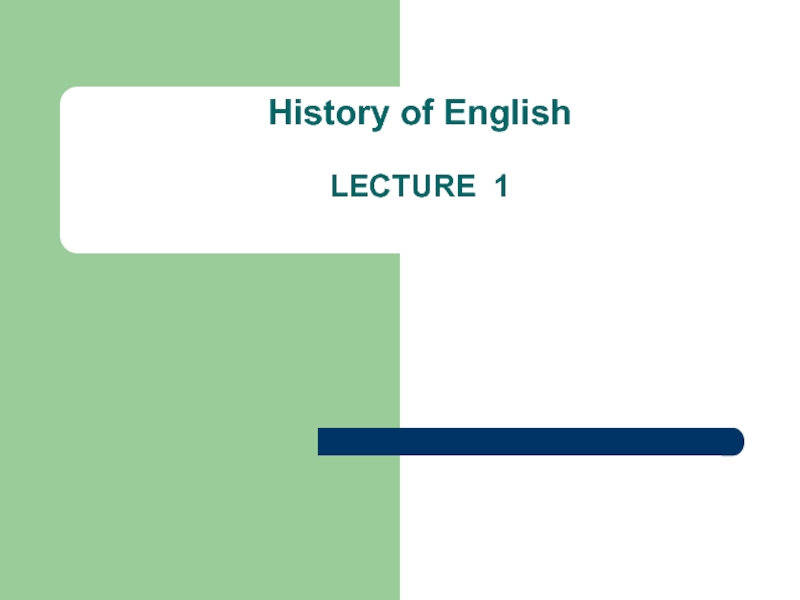

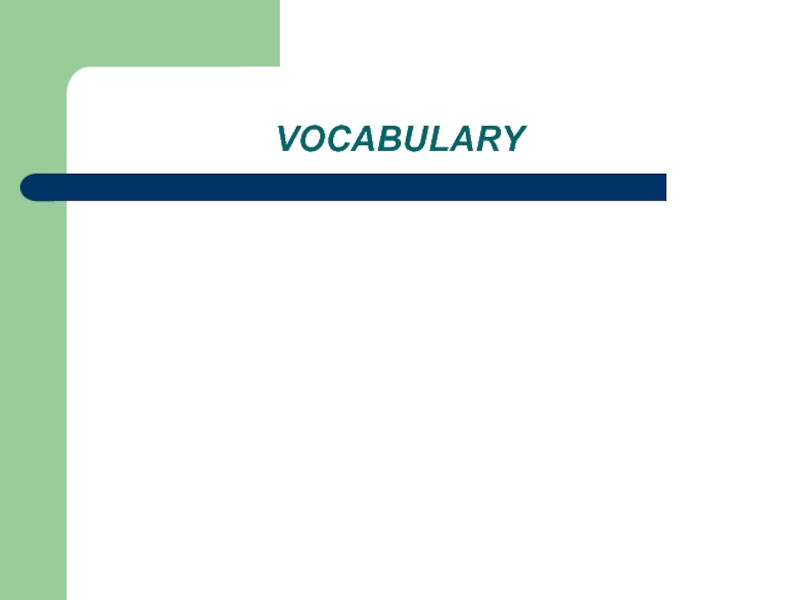
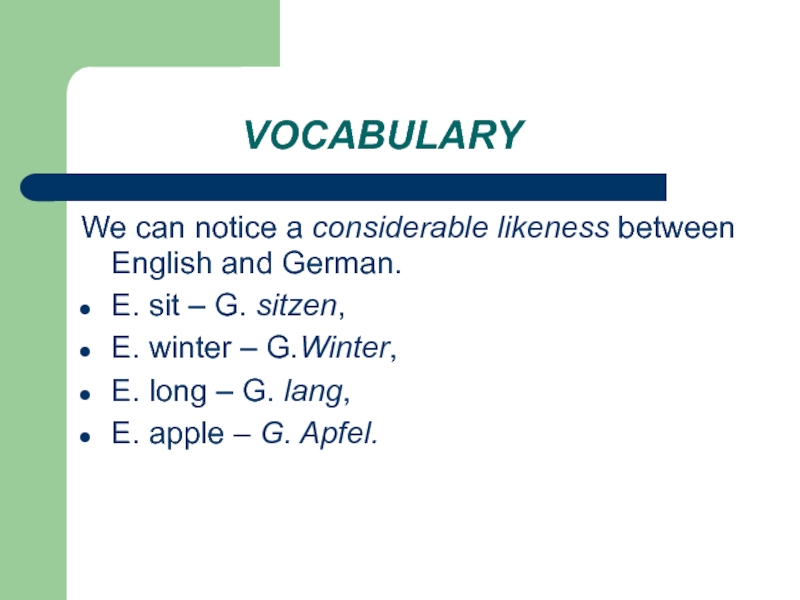

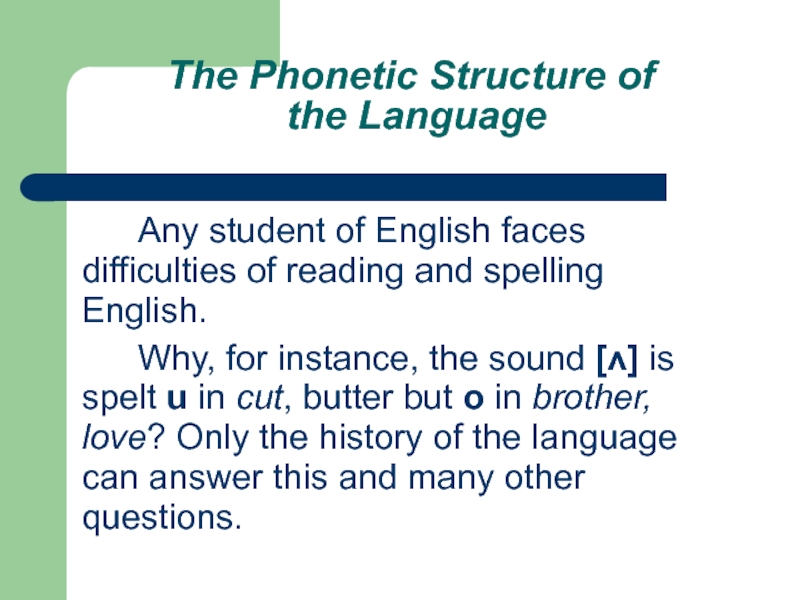

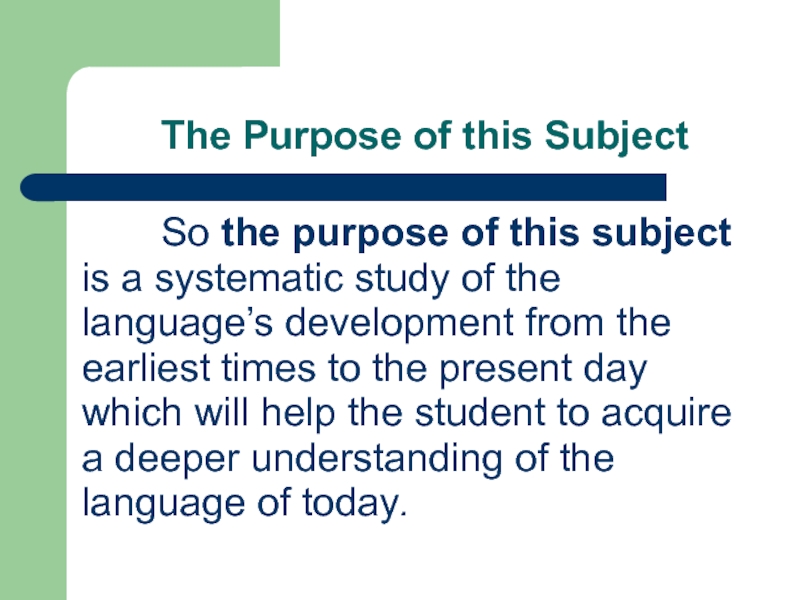
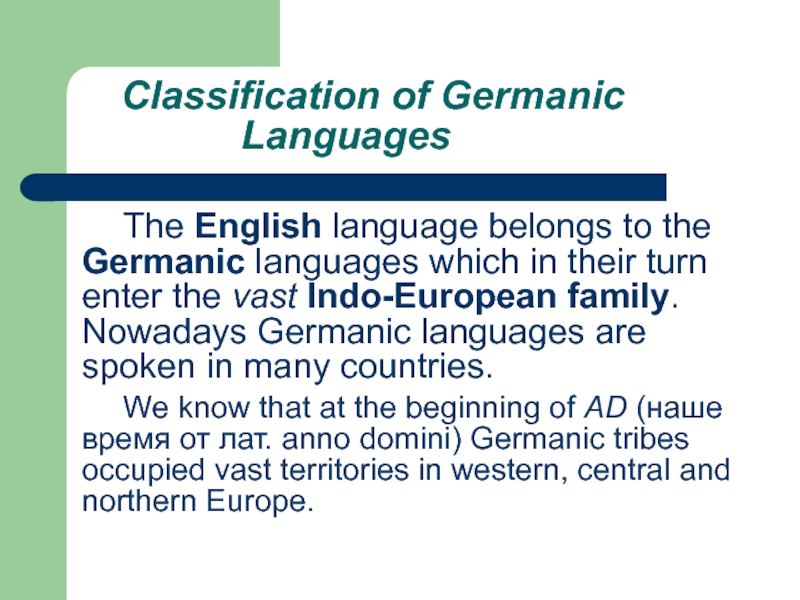
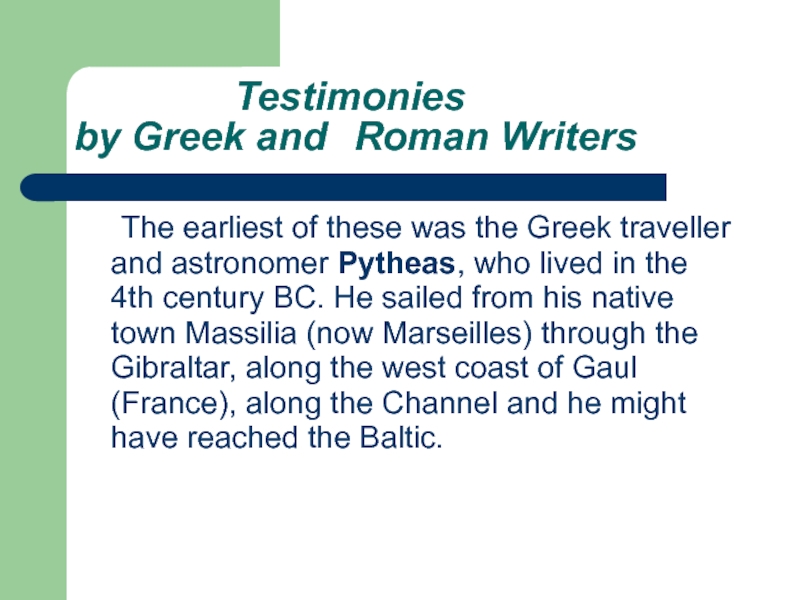
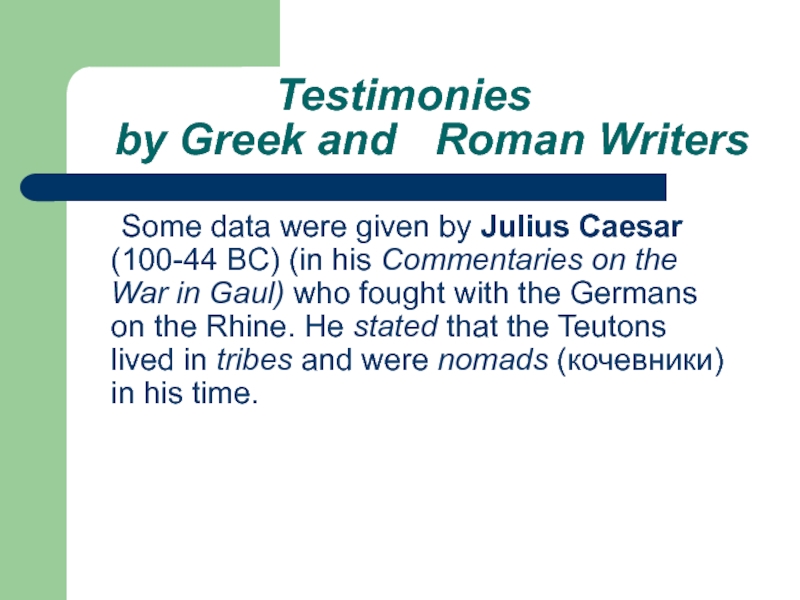

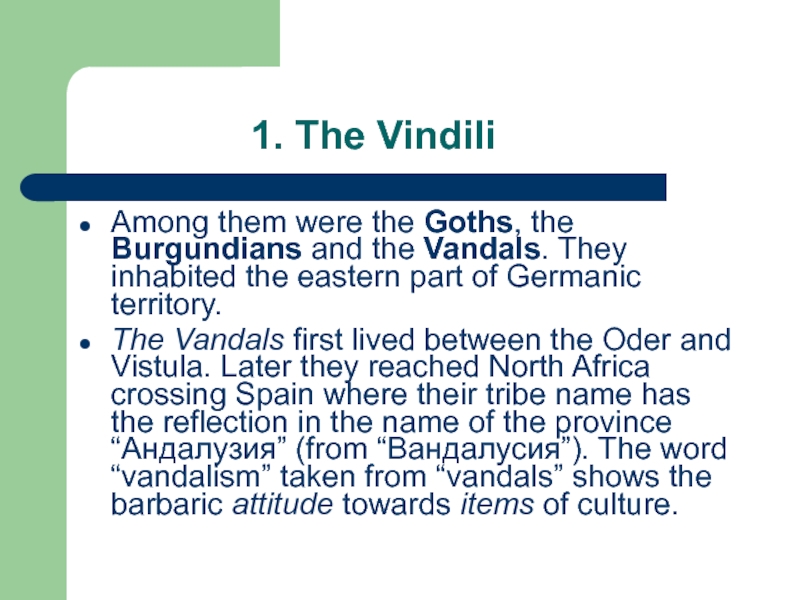
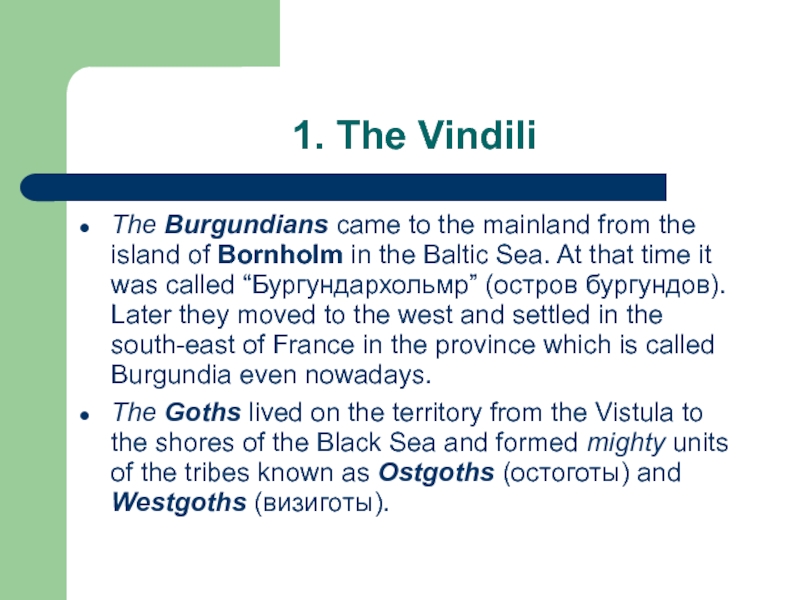
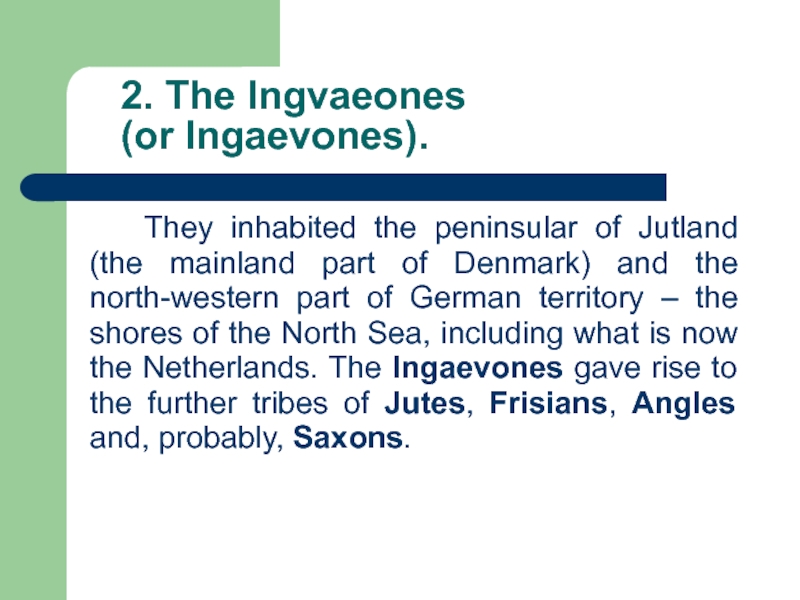
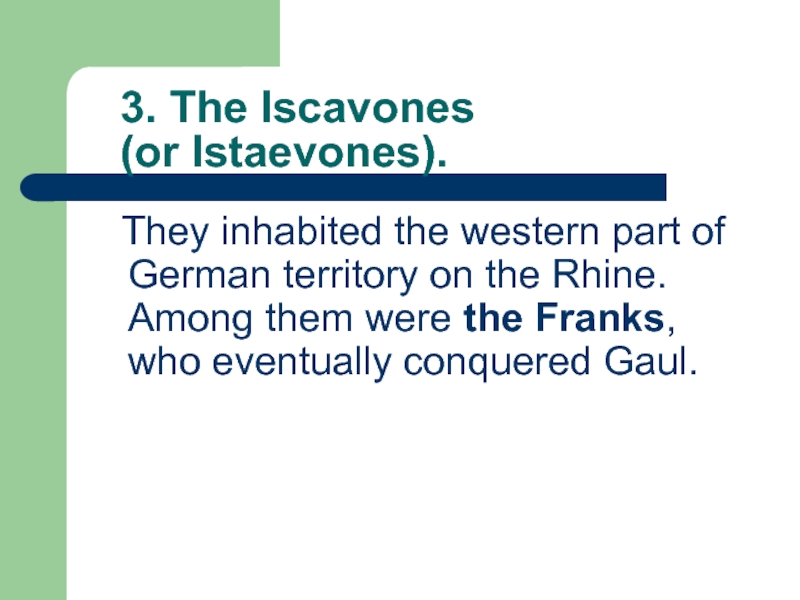

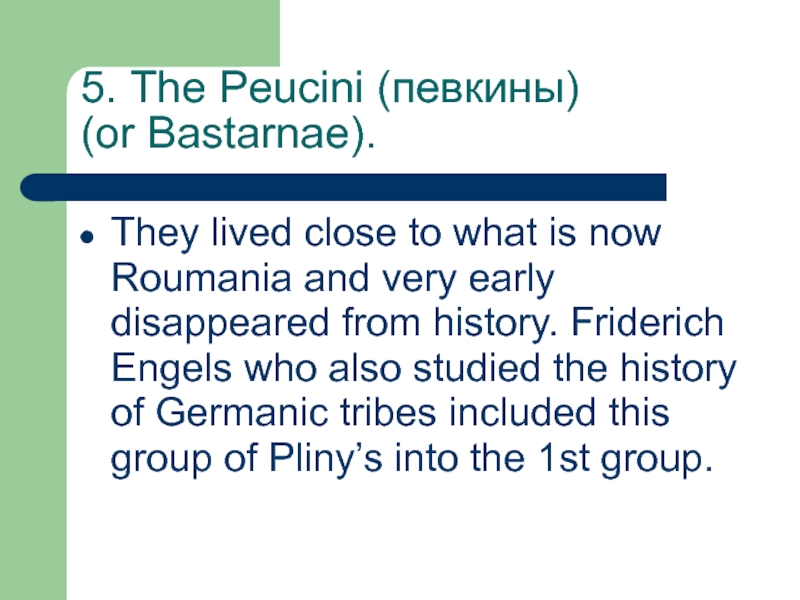

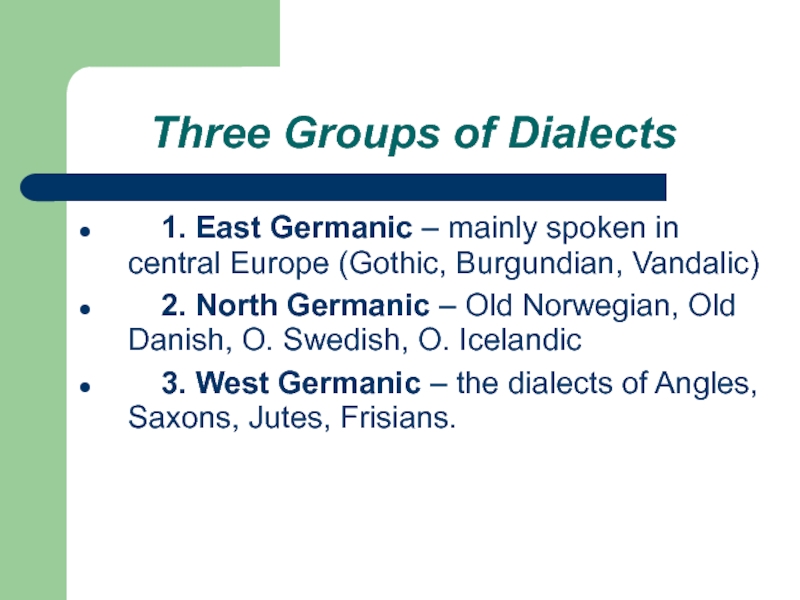
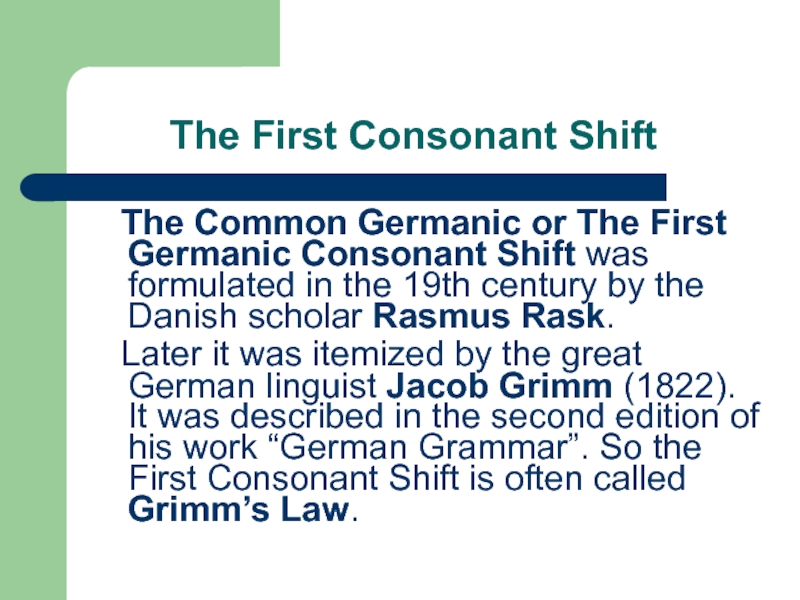
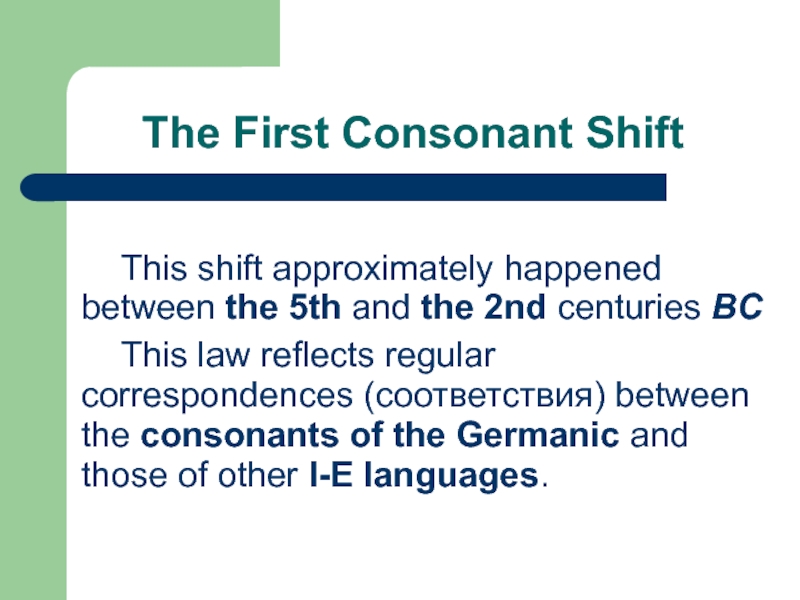
![Three Groups of CorrespondencesI-E Germanic1. p R. папа f E. father t R. три þ [θ] E. three k Lat. noctem h Germ. Nacht2. b R. болото p E.](/img/tmb/5/472089/b8de75101b8696b398bab881d84e1b2f-800x.jpg)

